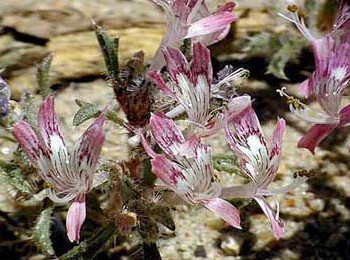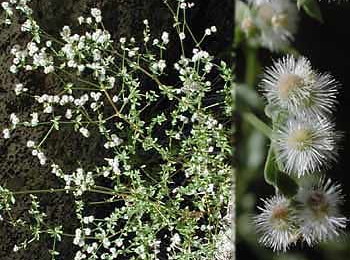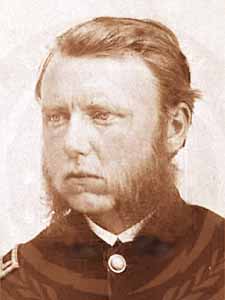WHO'S IN A NAME?
People Commemorated in Eastern Sierra Plant Names
Return to Index
Desert Calico, Loeseliastrum matthewsii (A. Gray) S. Timbrook (Polemoniaceae)
~ and ~
Bushy Bedstraw, Galium matthewsii A. Gray (Rubiaceae)
by Larry Blakely
References and Notes
(First Posted: 1999 09 05; Last Revised: 2001 10 18; Text appeared in the newsletter of the Bristlecone chapter, CNPS, September, 1999/Vol. 19, No.5)

Desert Calico, Loeseliastrum matthewsii (A. Gray) S. Timbrook

Bushy Bedstraw, Galium matthewsii A. Gray
Check the CalFlora website for more information and pictures.
Photos © by Larry Blakely
The exquisite Desert Calico, which charms all who drop to knees and forearms for a closer look, is found blooming up and down the Owens Valley in May and June. Its range extends across the deserts to the south and east, and into Nevada. It was among a collection of Owens Valley plants made by Washington Matthews in 1876 and/or 1877, and sent to Asa Gray at the Harvard Herbarium. Gray honored Matthews by naming it for him, along with one other previously undescribed plant, the Bushy Bedstraw. (2)

Washington Matthews
(National Library of Medicine)
Matthews (1843-1905) was born in Ireland but was raised in Iowa, his family having moved to this country when he was a child. Following in his father's footsteps, he became a medical doctor, and, upon receiving his degree in 1864, took up service in the US Army. After the Civil War he stayed on as a US Army surgeon, and was posted to several camps and forts around the West, from the plains of the upper Missouri River, to California, Nevada, and New Mexico. As was often the case with nineteenth century Army doctors in the West, Matthews pursued scientific interests in his spare time. Collecting plants was one of Matthews' interests, but his chief interest was Native American ethnography. His extensive studies of Hidatsa and Navajo cultures brought him international recognition. Present-day Navajos, in search of knowledge of their heritage, consult not only tribal elders but also Matthews' sensitive works, such as Navaho Legends published in 1897. (3), (4), (5), (6)
Matthews was ordered to Camp Independence in April of 1876 to replace the then current Camp's doctor, who was about to depart for another post. In early May he paid a visit to the offices of the Inyo Independent, which reported in its May 13 issue:
"We were this week favored with a call from Dr. Washington Matthews, Post Surgeon of Camp Independence. He manifests considerable interest in regard to Inyo in general, particularly her geology, natural curiosities and the evidences of former races visible upon the pictured rocks near Fish Slough to the northward and among the hills of Cerro Gordo on the south. When called upon to do so the doctor will attend to the practice of his predecessor - his card being given in this issue."
Perhaps by the time of Matthews' visit to the offices of the Independent he had already discovered the Desert Calico in bloom.
Over the ensuing months, the Independent reported instances of his treating civilians, including the vaccination of hundreds of Owens Valley Native Americans against smallpox. He was also reported to have come in second in a Christmas Day archery contest held near the Court House, which drew most everyone in town. In July of 1877, at the time of the closure of Camp Independence, Matthews left the Owens Valley to assume the surgeon's position at another Western fort. (7)
In September of 1880 Matthews was assigned to Fort Wingate, N. M., where he began learning about the Navajo peoples and their culture. He also collected plants in New Mexico; a new species in his 1882 collection was named for him, Astragalus matthewsii S. Wats. (Sereno Watson was an assistant to Asa Gray). He was not quite 50 when he suffered a stroke, which ended his military career but not his Navajo studies. His book, The Night Chant: A Navaho Ceremony, considered "probably the best tribal study ever published," appeared in 1902, not long before his death. (8), (9), (10)
REFERENCES and NOTES
1. Cronquist, Arthur, Arthur H. Holmgren, Noel H. Holmgren, James L. Reveal, and Patricia K. Holmgren. 1984. Intermountain Flora. Vol. 4 Subclass Asteridae (except Asteraceae). New York Bot. Gard., Bronx. (p. 533)
2. Desert calico has been shuttled between different genera (Loeselia, Gilia, Navarretia, and Langloisia), always retaining the matthewsii specific epithet (see Cronquist (1), p. 139).
3. Short biographies of Matthews:
McNeley, Grace Anna. 1994. An Appreciation of Washington Matthews. Foreward to a reprint of Matthews' Navajo Legends, Univ. of Utah Press.
Sohn, Anton Paul. 1998. A Saw, Pocket Instruments, and Two Ounces of Whiskey. Frontier Military Medicine in the Great Basin. Arthur H. Clark Co., Spokane, Washington. (p. 178)
Ewan, Joseph. 1950. Rocky Mountain Naturalists. Univ. of Denver Press. (p. 260)
There is also a master's thesis: Poor, Robert Marshall. 1975. Washington Matthews: an Intellectual Biography. Univ. of Nevada, Reno (GN899.P66 1975).
4. Matthews, Washington. 1877. Ethnography and Philology of the Hidatsa Indians. Washington, Gov't Printing Office. [The entire work is available on line.]
5. Matthews, Washington. 1897. Navaho Legends. Houghton, Mifflin, Boston (1994 reprint by Univ. of Utah Press.)
6. Matthews' international repute came early. As one example of his impact on anthropology and psychology, Charles Darwin consulted Matthews while gathering information on various cultures for the following study, and referred to his input at several places in the finished work.
Darwin, Charles. 1872. The Expression of the Emotions in Man and Animals. D. Appleton and Company: New York, all on-line.
Here is one instance from Chapter 9: Reflection, Mediation, Ill-temper, Sulkiness, Determination:
Perplexed reflection is often accompanied by certain movements or gestures. . . . . Mr. Washington Matthews, who attended to some of the wildest tribes of Indians in the western regions of the United States, remarks that he has seen them when concentrating their thoughts, bring their "hands, usually the thumb and index finger, in contact with some part of the face, commonly the upper lip." We can understand why the forehead should be pressed or rubbed, as deep thought tries the brain; but why the hand should be raised to the mouth or face is far from clear.
7. Many thanks to Nancy Masters, of the Independence Branch of the Inyo Co. Library, for help with the microfilmed archives of the Inyo Independent. (The card mentioned in the quote was actually found in the May 20 issue.) Thanks also to Bill Michael of the Eastern California Museum for steering me onto Matthews sources.
8. A synonym for A. matthewsii is Astragalus mollissimus var. matthewsii (S. Wats.)Barneby.
9. The quote is from McNeley, (3).
10. Matthews, Washington. 1902. The Night Chant, A Navaho Ceremony. Amer. Museum of Natural Hist., New York.
Matthews translated Navajo poems for this work, including House Made of Dawn, the final stanzas of which are reproduced below. The entire poem may be found at this site:
In beauty I walk.
With beauty before me, I walk.
With beauty behind me, I walk.
With beauty below me, I walk.
With beauty above me, I walk.
With beauty all around me, I walk.
It is finished in beauty,
It is finished in beauty,
It is finished in beauty,
It is finished in beauty.